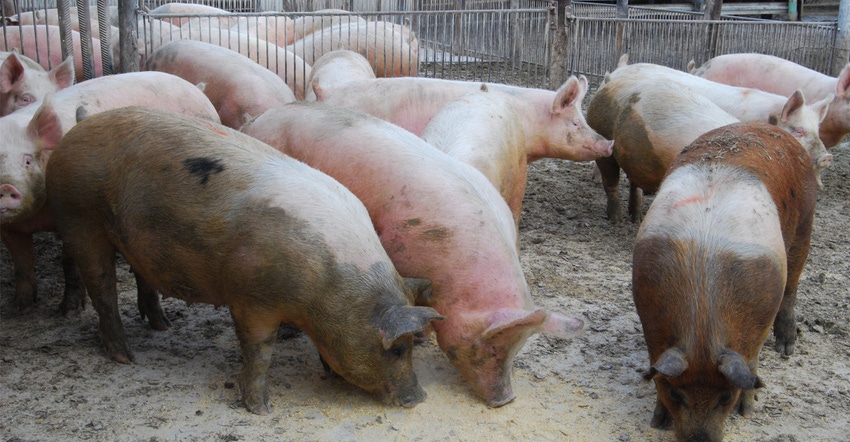October 17, 2018

Trade policy uncertainties whipsawed spring and summer hog markets. Little uncertainty exists over fourth-quarter hog supply. December slaughter runs will be record large. Few people expect a repeat of the December 1998 hog price wreck. That year slaughter hog supply exceeded slaughter capacity. Hog prices dropped below $20 per live cwt. for two months.
Producers must avoid letting market hogs back up on the farm this fall. From October into December 1998, Iowa-Minnesota slaughter weights jumped 10 pounds. Keeping marketings current now can avoid adding even more tonnage to the market. Fall 2018 slaughter weights have been holding steady. This suggests a backlog of hogs has not developed — at least so far.
Trade policy impacts on prices
Producer-sold Iowa-Minnesota hog prices for all purchase types peaked in the third week of June at almost $82 per cwt. Prices then collapsed to a low of $46 per cwt to end August. They recovered to finish September near $65 per cwt. Purchase types include negotiated, other market formula, swine or pork market formula, and other purchase agreements.
The spot market or negotiated basis price plunge was even more severe, falling to the upper $30s in late August before rebounding to end September in the low $60s. Recent occasional wide spreads between negotiated prices and total weighted average prices highlight the plight of producers trying to negotiate in the current whipsaw market environment.
Commercial pork production this year has been up 3.9% compared to the first eight months of 2017. This year’s pork production will be record high at about 26.5 billion pounds. Next year will set another record near 27.1 billion pounds.
Record supplies could pressure packing capacity limits during peak hog slaughter weeks in the fourth quarters of both 2018 and 2019. Traditionally hog slaughter peaks one or two weeks after Thanksgiving. Even if the industry has adequate slaughter capacity, it still must find a market for the big pork supply.
Export volume up, value down
The key feature shaping the summer 2018 U.S. pork market was the anticipated negative impacts of Mexican and Chinese tariffs on U.S. pork exports. The duty rate on most U.S. pork entering Mexico rose from 0% to 10% in early June and from 10% to 20% in early July.
In China, the duty rate on U.S. pork and pork variety meat surged from 12% to 37% on April 1, and to 62% on July 6. The lean hog futures market took this news as a huge hit on market clearing prices. October lean hog futures prices, as an example, fell from about $63 in June to under $50 by early August.
October futures did recover from the early-August swoon, rising back to $62 per cwt by end of September. Futures markets anticipate supply-and-demand conditions into the future. Sometimes the bad news isn’t as severe as originally anticipated.
July export volume of U.S. pork (excluding pork variety meat) was 8% higher than a year ago, according to data released by USDA and compiled by the U.S. Meat Export Federation (USMEF). But in general, pork exports sold at lower prices driving total export value down 3% in July.
July export volume to Mexico was unchanged from a year ago but value fell 24%. The good news is the announcement on September 30 of the trade agreement between the United States–Mexico–Canada (USMCA) should bring relief at some point from Mexican tariffs that have impacted U.S. hog prices. It is important to note that the retaliatory duties imposed by Mexico on U.S. pork remain in place for now.
July exports to China were down 12% from a year ago, while value dropped 17%. For January through July, pork exports to China dropped 14% year over year in volume and 11% in value due in part to the higher duty rates, but also due to an upward trend in China’s domestic pork production. Last year 7% of all U.S. pork exports went to China, 35% went to Mexico.
Pork exports have been quite strong to other major markets. For January through July, exports to Japan matched last year in volume and were 1% higher in value. South Korea has been the 2018 U.S. pork export market star, with exports up 42% from a year ago in volume and 47% in value. Pork exports to South America rose 40% in volume and 36% in value. Growth in all seven Central American nations pushed pork exports to the region 17% above 2017’s pace in volume and value. The Dominican Republic has also been a top growth market this year, with exports up 21% in volume and value up 18%. Exports to the Philippines in 2018 year to date climbed 4% higher in volume and 3% higher in value.
USDA’s World Ag Supply and Demand Estimates for September project 2018 U.S. pork export volume over 6% higher than in 2017. 2019 exports are expected to rise about 2% over 2018’s forecast. Those larger exports will be needed to absorb higher production.
Production expansion steady
USDA released its Sept. 1 hogs and pigs inventory estimates on Sept. 27. These estimates are based on producer surveys. Historically, the Sept. 1 inventory is the largest inventory of the calendar year, and this year is no exception. The report showed a U.S. inventory of 75.486 million total hogs and pigs with a 6.330 million head breeding herd and 69.156 million market hogs. The market hog inventory was 2.9% higher than on Sept. 1, 2017.
The breeding herd inventory was up 3.5% from Sept. 1, 2017. The breeding herd rose only 10,000 head in June to September quarter, suggesting some expansion is still occurring. But producers may be tempering expansion plans in response to lower markets. Overall, the report numbers were near pre-report trade expectations.
Iowa productivity gains stall
For the first time, Iowa had 23 million hogs and pigs in inventory, with market hogs up 4.3% compared to a year ago and the breeding herd up 6.1%. Iowa produced more pigs as a result of expansion of herds rather than from gains in productivity. A flip of what has been leading to growth in pig numbers in the past.
The Iowa pig crop was estimated at 6.384 million pigs for the June through August quarter, up 9.6% from last year. This all came from the 9.6% more sows farrowing. Pigs saved per litter were unchanged from 2017.
Iowa’s farrowing intention estimates don’t quite jibe with the current size of the breeding herd. September through November farrowing intentions are up just 1.8%. Given the size of the Sept. 1 breeding herd, one would expect September through November sows farrowing to be about 5.8% higher than last year.
This would be consistent with a farrowing ratio (farrowings divided by breeding herd) of 56.1%, which is in line with the last two September through November quarterly estimates. Iowa-Minnesota sow slaughter has been up 14% compared to last September. This may help explain the smaller-than-expected farrowing intentions.
Iowa remains the primary destination for weaned and feeder pigs, both from other U.S. states and Canada. In the latest USDA Market News Service National Direct Delivered Feeder Pig Report for the week ending Sept. 28, Iowa was the destination for over 80% of the reported volume. Iowa was also the origin for 16.8% of state out shipments, likely bolstered by the large pig crop.
Schulz is the Iowa State University Extension livestock economist.
About the Author(s)
You May Also Like






